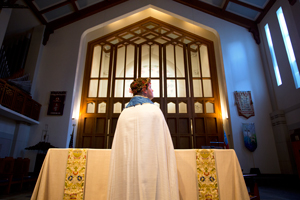
A finer performance has rarely been heard in Greater Cincinnati than the University of Cincinnati College-Conservatory of Music’s “St. John Passion” by Bach Nov. 3 at Christ Episcopal Church.
A staged performance led by CCM’s Earl Rivers, it was superlative in every way: singing, playing, dramatics, venue, lighting, concept, all tastefully done and with sublime musicality. The staging by Omer Ben-Seadia, artist diploma candidate in directing at CCM, was conservative, with primary emphasis on the music. There was little costuming and few props: the Evangelist’s book, a chair, Pilate’s scroll. There were entrances and exits and ample opportunity for character portrayal, however. Tenor Jeffrey Thompson, visiting artist at CCM, was the Evangelist, with baritone Conor McDonald as Jesus and baritone Jeff Byrnes as Pilate.
The aria soloists/disciples were soprano Danielle Adams, mezzo-soprano Lauren McAllister, tenor Alec Carlson, baritone Jonathan Cooper and bass Stefan Egerstrom, all graduate voice majors at CCM. Rivers led a 29-piece orchestra drawn from CCM’s Philharmonia Orchestra and a 29-voice Chamber Choir. Guest artist, cellist Adriana Contino, played continuo and obbligato cello, with faculty artist Michael Unger at the harpsichord. English translations were projected onto a pair of video screens at either side of the church. Enhancing the performance was the lighting, which changed colors throughout, creating an atmospheric backdrop through the windows behind the altar.
At approx. one hour and 50 minutes, Bach’s “St. John Passion” is roughly half as long as his “St. Matthew Passion.” Drawn from the biblical Gospel of John, it recounts the last hours of Jesus’ life. It is more direct and immediate, with more emphasis on conflict, than the “St. Matthew Passion.” The solemn, roiling chorus with which it begins, “Herr, unser Herrscher” (“Lord, Our master”), set the tone immediately, its vivid coloration and anguished pleas, reflected handsomely by the church’s welcoming acoustics.
A CCM alumnus and noted baroque interpreter, Thompson expressed every drop of feeling from his role, whether delivering his own narrative or interacting with the other characters. Often, he turned his head away in disgust as the course of events proceeded. As Peter denied Jesus the third time, Thompson walked to him and pronounced accusingly, “weinete bitterlich” (“he wept bitterly”). He then walked off indignantly.
When the chorus demanded the release of Barabbas instead of Jesus, Thompson reacted with shock, crying “Barabbas aber war ein Mörder” (“But Barabbas was a murderer”), and he circled Jesus with horror as the purple robe and crown of thorns were laid upon him. He cradled Jesus’ robe as the chorus sang of the soldiers casting lots for it, and as Jesus cried “I thirst,” he held up a cup from which red petals fell.
As baritone Cooper sang the heart-rending aria “Mein teuer Heiland” (“My beloved Saviour”) Thompson fell to his knees and reached out toward Jesus as if he finally understood. At the end, he exited weeping.
McDonald as Jesus displayed a warm baritone voice, submitting to his torture meekly but firmly, moving to a side balcony over the nave for the crucifixion scene. Pilate received a strong interpretation from baritone Byrnes, who was dressed in a black judicial robe during the trial and expressed deep feeling and sympathy for Jesus. At one point, he seized Jesus to convince him of his power to release him, then gave him a stricken look as Jesus refused help. As McDonald walked down the center aisle to the cross, Byrnes slammed a chair to the floor in anger and unfolded the scroll to be nailed to his cross (“Jesus of Nazareth King of the Jews”).
Another central figure was Peter, sung by Carlson. He covered his ears in terror as he was questioned about Jesus, then realizing what he had done, sank to his knees and sang passionately “Ach mein Sinn, wo wilt du endlich hin? (“Ah, my soul, whither wilt thou fly?”).
The meditative arias were beautifully sung, with fine obbligato accompaniments by oboe/English hornists Katelyn Kyser and Martha Peck, flutists Xue Su and Carol Joe and violinists Haoli Lin and Yang Liu. They included mezzo-soprano McAllister’s “Von den Stricken meiner Sünder” (“From the bondage of transgression”), soprano Adams’ “Zerfliesse, mein Herze” (“Dissolve my heart”), Cooper’s “Betrachte, meine Seel” (“Consider, O my soul”) and Egerstrom’s “Eilt, ihr angefochtnen Seelen” (“Haste, ye deeply wounded souls”).
The chorus played its important role with distinction, both acting as the crowd demanding Jesus’ death and singing the deeply affecting choruses and chorales that fill and frame the work, such as the lullaby-like “Ruht wohl” (“Rest in peace”) at the end. Rivers led a baroque-styled, period accompaniment full of reflection and emotion, conjuring Bach as few interpreters can.
The one-time-only concert, which was presented in collaboration with the 2013 Constella Festival of Music and Fine Arts, demands an encore performance.